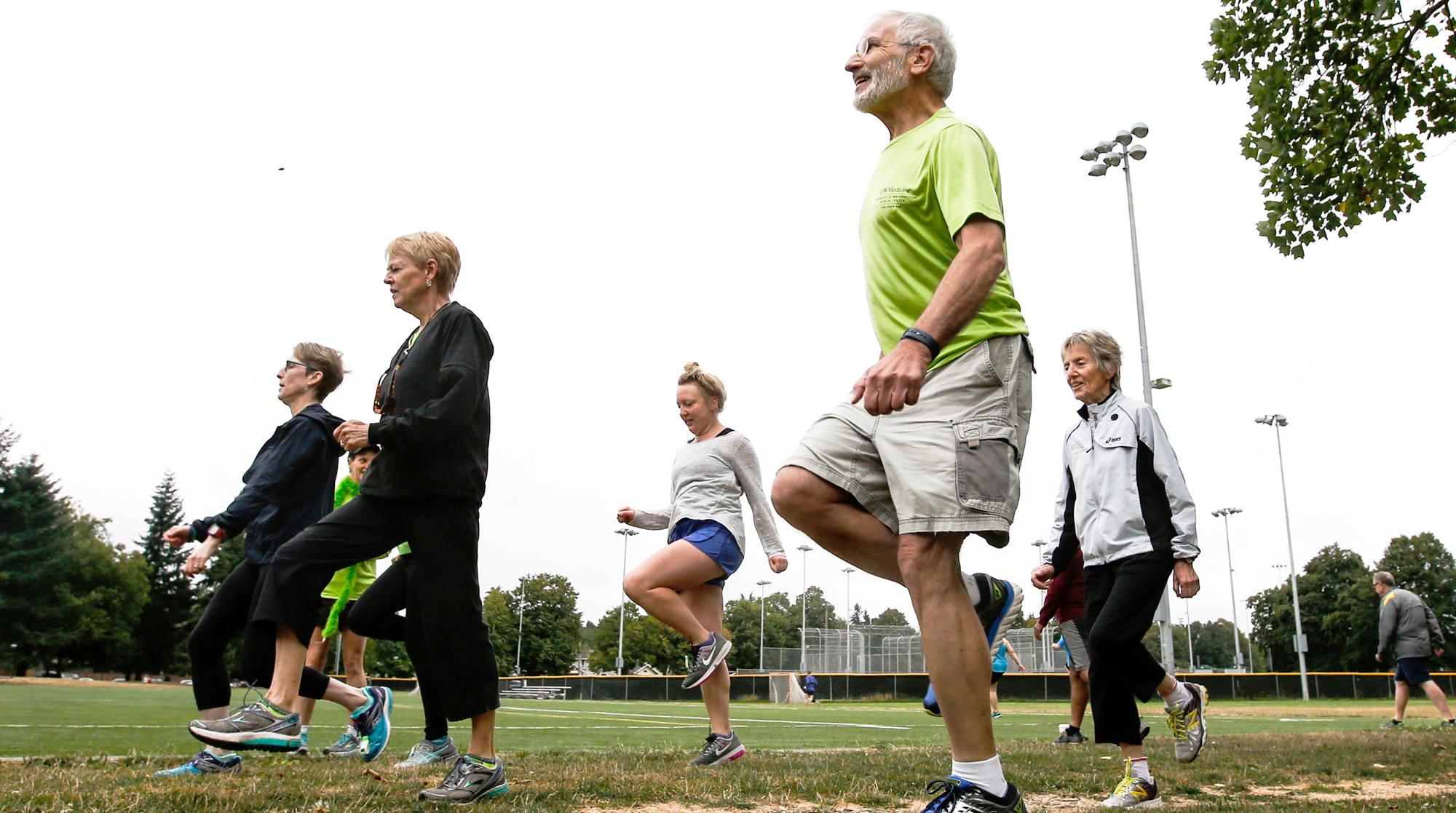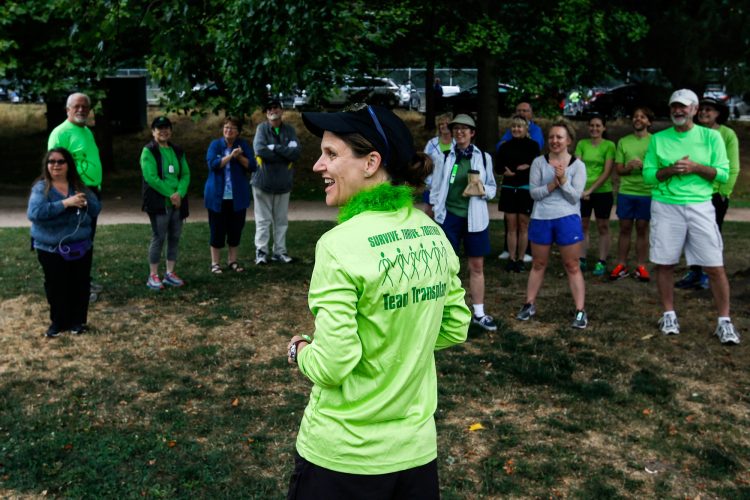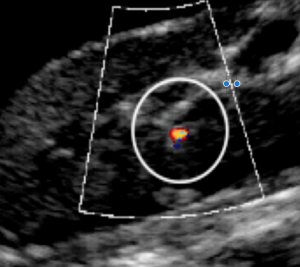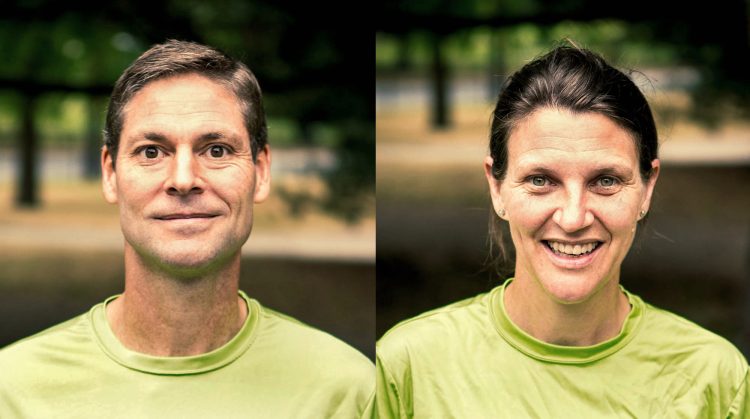

Alysun Deckert served as the nutritionist for UW Medicine's Transplant Program for 20 years. Yet, when she talks about a “good match,” she isn't talking about kidney or heart transplants. She’s talking about her husband, UW Associate Professor Michael Bailey, who works in the Applied Physics Laboratory. He’s developing a new ultrasound treatment that’s the first new remedy for kidney stones to come along in 30 years.
However, kidneys are not the only tie that binds the couple: They run like greyhounds, at times averaging between 30 and 40 miles a week. In fact, cupid struck when the pair first met at a Wednesday night run led by a UW researcher.
“I think, technically, it was me who asked him out first,” recalls Deckert, who started running in high school and has competed in the U.S. Olympic marathon trials. The couple married four years ago in a ceremony at the Woodland Park Zoo. “It made sense because it’s close to the Green Lake track,” she says.
On Saturday mornings, Deckert leads Team Transplant, a running and walking group composed of dozens of UW patients who have undergone an organ transplant. Instead of just advising he transplant patients to exercise, Deckert decided in 2001 to do something about it. She invited patients, their families and UWMC employees to join her on a Saturday morning run, and ever since the group has trekked all over the city. Most all of the team’s members have participated in the Seattle Marathon, the Rock & Roll Marathon and the ever popular UW Dawg Dash.

Alysun Deckert addresses a group gathered for a morning run around Green Lake in Seattle on a Saturday in August.
Team Transplant started training for the fall season in mid-August. For safety and guidance, Deckert directs and monitors the workout from her car. Her husband was there, too.
Sometimes the couple talks about kidneys, although Deckert is now clinical nutrition manager at UW Medical Center and is no longer one of the transplant dietitians. Deckert shares Bailey’s excitement about his work, which promises to transform the treatment of patients with kidney stones, a condition that affects one in 11 Americans and causes intense pain.
NASA funded the Applied Physics Lab (APL) to develop the new ultrasound treatment for astronauts who are at higher risk for stones because of bone demineralization in microgravity. The condition can derail a mission and even become life-threatening.

A kidney stone spotted on an ultrasound.
To understand the technology, think about the tractor beams used on “Star Trek.” Focusing acoustic waves around the stone can create pressure. Then a transducer, like the kind used to provide an ultrasound picture of a fetus, nudges the kidney stone, which pushes small or obstructing stones out of the kidney or ureter.
The next step will be to grab the stone and drag it when it is not suitable to push the stone away. Moving stones is then being combined with new technology developed with colleagues at APL and in UW Urology to potentially break larger stones in a pain-free way.
The advantage of this treatment is that traditional lithotripsy, which shatters the stones, requires a patient to undergo general anesthesia and have the procedure done in an operating room. The new ultrasound device can be used in an emergency room or clinic setting.
Stones can block the ureter and urine can swell the kidney. That’s what causes the pain people feel when they have a stone. There are more than one million admissions to the nation’s emergency rooms for kidney stones each year.
The success of the NASA-funded trials at UW led to installation of the technology on NASA’s Flexible Ultrasound System (FUS), as well as a spin-off company that expects to market a device starting in 2018.

Michael Bailey and Alysun Deckert
The ultrasound device isn’t very big, which is why physicians will soon be able to use it in the ER or an outpatient clinic. The UW team has also enhanced the imaging capabilities to make it easier for a physician, tech, Army medic, or astronaut who isn’t an ultrasound expert to identify the kidney stones more easily for diagnosis and targeting.
The system is designed to be as easy to use as portable defibrillators found in schools and churches. It comes with a series of apps—the training app, the stone-breaking app, the nudging app—to make it simple to use.
So while Bailey is working on treatment for patients with kidney stones during his workday, he and Deckert are spending their time outside of work with the kidney and other organ transplant community—along with many other UW couples in similar situations. In a matter of seconds, Bailey and Deckert can name over a dozen couples in the transplant and urology communities who have separate focuses at UW and also share mutual efforts in another area of giving to the UW community.